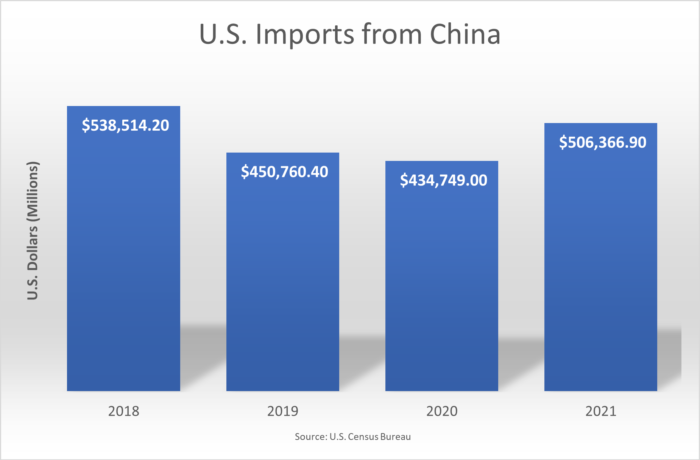Made in China: Is it worth the cost?
By NNR USA In Insight On 17th February 2022

Updated 04/14/2022
U.S. tariffs are more expensive on imports made in China than on imports made in nearly any other country.
Despite high tariffs, China continues to be the number one U.S. import trade partner, supplying 19.3% of total U.S. imports in January 2022.
Importers have felt the effects of Trump-era Section 301 China tariffs on their pocketbooks for the past four years. Nevertheless, imports from China continue to trend upward in value. 
The Biden Administration has provided few hints on the future of the tariffs. Meanwhile, agreements have been made with allies such as the E.U., Japan, and the U.K., amongst others, to fight unfair market practices, environmental concerns, and forced labor issues. In January, the U.S. Trade Representative (USTR) announced its plans to "develop its first-ever focused trade strategy to combat forced labor."
What does this mean for importers? The forced labor strategy might be one of the most challenging actions importers will need to consider when sourcing products from China. Importers will need to thoroughly vet their supply chains, documenting the process and findings to a degree U.S. Customs finds suitable. It will take time and money, and it may prove to be quite difficult.
There is no doubt the U.S. has a strong focus on imports from China.
How Much Do Importers Pay?
Today, U.S. importers of "Made in China" products pay extremely high additional tariffs, often at 7.5% or 25% of the imported cost. Since 2018, importers have spent more than $125 billion in additional Section 301 duty.
A variety of other not so insignificant additional tariffs may also apply to imports of Chinese origin:
- Section 201 on washing machines(14-50%) and solar panels (14-14.75%)
- Section 232 on certain steel (25%) and aluminum (10%) products
- Antidumping and Countervailing Duty on a long list of products
Section 301 Tariff Relief
As for product exclusions that provide Section 301 tariff relief on certain products, there were over 2,800 exclusions available at one point. Today, there are only 433 exclusions available, of which 81 are on Covid-related medical products, scheduled to expire May 31, and 352 exclusions scheduled to expire Dec 31.
There is no indication if other exclusions will be considered for reinstatement or if the exclusion process will restart.
There's also the possibility the tariffs will begin expiring on Jul 6, 2022, on their 4th birthday. However, it seems unlikely since China fell 1/3 short of its Phase 1 purchase commitment of an additional $200 billion of American goods.
For the time being, the high tariffs will remain in place, with little relief available to importers.
The trade war is still on.
Forced Labor Policy Heating Up
Besides the high tariffs, watch out for forced labor laws on Chinese imports. Today, if you are importing from China, you need to be on high alert for forced labor in your supply chain.
Currently, China is the subject of 5 of 7 active forced labor findings and 35 of 53 active Withhold Release Orders (WRO).
It's prohibited to import a product made wholly or in part with forced labor.
Products arriving at a U.S. port will be detained if the merchandise is covered by a WRO indicating a reasonable suspicion that forced labor was used. Products covered by a finding will be subject to seizure and forfeiture. For U.S. Customs to release goods, the importer will need to provide evidence that no forced labor was used to produce the merchandise.
The burden of proof falls on the importer. It will be necessary for importers to dive deeper upstream into the supply chain of their imported products. There may be site visits, audits, and interviews involved. This will require more transparency than ever from suppliers and their suppliers. The process may be challenging as suppliers could be hesitant to divulge information down to raw materials.
The latest U.S. trade strategy focuses on forced labor enforcement. It's important to note the strategy is not explicitly directed at Chinese goods. However, the announcement follows the law passed by Congress in Dec 2021, prohibiting goods made in whole or part with forced labor originating from China's Xinjiang Uyghur Autonomous Region (XUAR), which goes into effect on Jun 21, 2022.
Is Importing from China Worth It?
China can manufacture goods very economically. There are a wealth of suppliers available with the right expertise. Even with extra tariffs and high shipping fees, it may continue to make sense to import goods from China financially.
The question I would like to challenge you with is:
Are you prepared to prove your supply chain is free of forced labor?
Vetting your Supply Chain
It's a great time to do a risk analysis for forced labor, whether you are importing from China or elsewhere.
Start with easy questions:
- Are any of your imports covered by an active WRO or Finding?
- How much do you know about your products' supply chain?
- Can you map your supply chain down to the raw materials used?
- Do you have a social compliance program in place?
- Do you have documentation to prove forced labor wasn't used in your supply chain?
U.S. Customs has resources available to help start your journey.
Written By
Tatiana Snigurski, LCB, CCS
Business Development Manager - Customs & Trade Compliance
NNR GLOBAL LOGISTICS USA - Chicago
Email: tsnigurski@nnrusa.com
